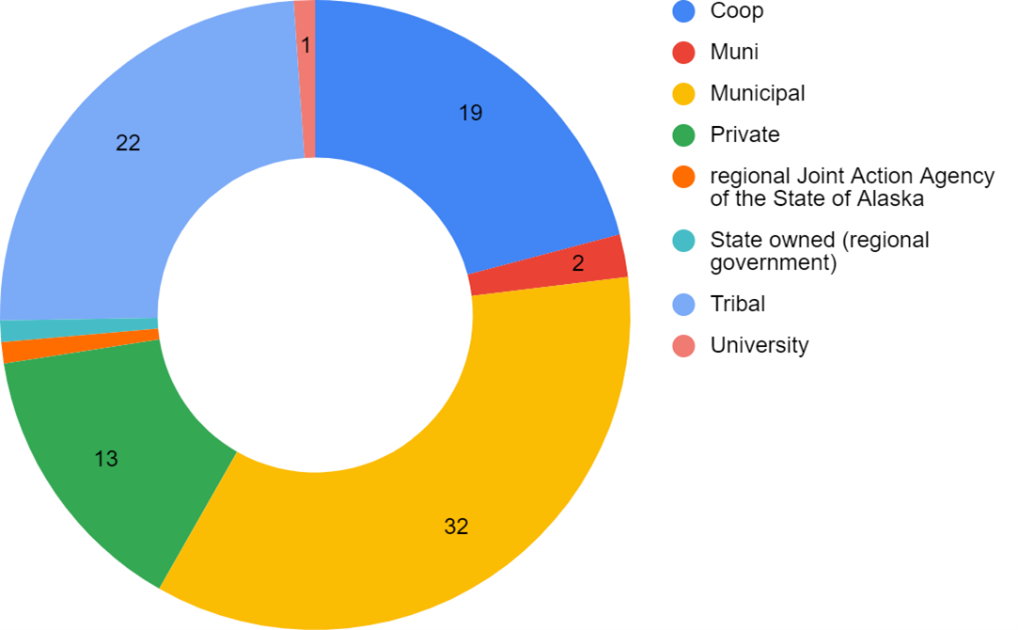Regulatory Structure
The Regulatory Commission of Alaska (RCA) has the authority to regulate both utilities and pipeline carriers within the state (Regulatory Commission of Alaska, 2018). The RCA exercises a delegated legislative power, and must reach its regulatory decisions quasi-judicially. In Alaska, most utilities providing services to ten or more customers require a certificate in order to operate. Certificates are issued by the RCA, which then regulates the rates, services, and practices of those utilities. The RCA also determines the level of support received by eligible customers under the Power Cost Equalization program. There are some utilities in Alaska that are not regulated, including local, government-owned utilities, very small utilities, and cooperatives whose members have voted to be deregulated.
Key Subsidies
The Power Cost Equalization Program (PCE) is a subsidy program providing economic assistance to communities and residents in rural Alaska where the cost of electricity is three to five times higher than for customers living in urban areas (Alaska Energy Authority, n.d.). The PCE is administered by the Alaska Energy Authority (AEA) and the Regulatory Commission of Alaska (AEA), and serves 82,000 people in 193 communities primarily reliant on diesel fuel. The program works by lowering the rates paid by PCE-eligible consumers to levels comparable to those paid by consumers in the urban areas of Anchorage, Fairbanks, and Juneau.
Power Project Fund (PPF) loan program provides loans to local utilities, local governments or independent power producers for the development, expansion or upgrade of electric power facilities, including distribution, transmission, efficiency and conservation, bulk fuel storage and waste energy; Power Project Fund
Alaska Energy Authority Community Assistance - AEA assists across the entire lifecycle of communities’ infrastructure—from identifying a community’s needs and goals to providing training needed to manage utilities and maintain infrastructure. - Energy Planning Project Development
Key Federal Programmes
The Regulatory Commission of Alaska (RCA) has the authority to regulate both utilities and pipeline carriers within the state (Regulatory Commission of Alaska, 2018). The RCA exercises a delegated legislative power, and must reach its regulatory decisions quasi-judicially. In Alaska, most utilities providing services to ten or more customers require a certificate in order to operate. Certificates are issued by the RCA, which then regulates the rates, services, and practices of those utilities. The RCA also determines the level of support received by eligible customers under the Power Cost Equalization program. There are some utilities in Alaska that are not regulated, including local, government-owned utilities, very small utilities, and cooperatives whose members have voted to be deregulated.
Key Subsidies
The Power Cost Equalization Program (PCE) is a subsidy program providing economic assistance to communities and residents in rural Alaska where the cost of electricity is three to five times higher than for customers living in urban areas (Alaska Energy Authority, n.d.). The PCE is administered by the Alaska Energy Authority (AEA) and the Regulatory Commission of Alaska (AEA), and serves 82,000 people in 193 communities primarily reliant on diesel fuel. The program works by lowering the rates paid by PCE-eligible consumers to levels comparable to those paid by consumers in the urban areas of Anchorage, Fairbanks, and Juneau.
Power Project Fund (PPF) loan program provides loans to local utilities, local governments or independent power producers for the development, expansion or upgrade of electric power facilities, including distribution, transmission, efficiency and conservation, bulk fuel storage and waste energy; Power Project Fund
Alaska Energy Authority Community Assistance - AEA assists across the entire lifecycle of communities’ infrastructure—from identifying a community’s needs and goals to providing training needed to manage utilities and maintain infrastructure. - Energy Planning Project Development
Key Federal Programmes
